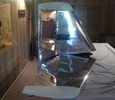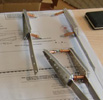


random user submitted photo
Leak check
7 posts
• Page 1 of 1
Leak check
I am considering filling my tank with water for a leak check. Any thoughts? On the C140 I was restoring I used air pressure but that is scary.
Bryan Cotton
Poplar Grove, IL C77
Waiex 191 N191YX
Taildragger, Aerovee, acro ailerons
dual sticks with sport trainer controls
Prebuilt spars and machined angle kit
Year 2 flying and approaching 200 hours December 23
Poplar Grove, IL C77
Waiex 191 N191YX
Taildragger, Aerovee, acro ailerons
dual sticks with sport trainer controls
Prebuilt spars and machined angle kit
Year 2 flying and approaching 200 hours December 23
-

Bryan Cotton - Posts: 5496
- Joined: Mon Jul 01, 2013 9:54 pm
- Location: C77
Re: Leak check
Petrol is a lot thinner than water. Petrol could leak where as water may not... plus would take quite some time and effort to dry it out...
Just a thought...
Just a thought...
Sonex 1645
VH-VWS
Tailwheel
Former Aerovee Turbo
Rotax 912
VH-VWS
Tailwheel
Former Aerovee Turbo
Rotax 912
- Brett
- Posts: 269
- Joined: Tue Apr 08, 2014 3:49 am
- Location: Geraldton W.A Australia
Re: Leak check
I left water in my tank for a few days before installing it in the airplane. It proved I had no major leaks, but I still ended up discovering a small leak once I added 100LL (an extra quarter turn on the fitting stopped the leak).
- gammaxy
- Posts: 601
- Joined: Wed Sep 04, 2013 9:31 am
Re: Leak check
Bryan Cotton wrote: On the C140 I was restoring I used air pressure but that is scary.
Bryan. I agree, air testing with too much pressure would no doubt be scary.
I would still be checking with air, just at an extremely low pressure. It is in my opinion the best way to test for leaks. Tape a balloon or glove to one of the fittings, you only need enough pressure to inflate the balloon which will also act as a pressure relief valve. Spray soapy water around the fittings to check for leaks.
Steve
Sonex 892
- sonex892
- Posts: 169
- Joined: Fri Jun 03, 2011 4:49 am
- Location: Port Macquarie Australia
Re: Leak check
I tested with water. It at least gave me a base line. There were a few months between doing my fuel system and flying the plane, so drying out was not an issue. My plane was in the basement, so I did not want to test with fuel. I did another check with just a couple of gallons of fuel once I had the plane at the airport.
Mike Smith
Sonex N439M
Scratch built, AeroVee, Dual stick, Tail dragger
http://www.mykitlog.com/mikesmith
Sonex N439M
Scratch built, AeroVee, Dual stick, Tail dragger
http://www.mykitlog.com/mikesmith
- mike.smith
- Posts: 1430
- Joined: Tue Jan 29, 2013 8:45 pm
Re: Leak check
Thanks for the thoughts guys. Steve, I did just as you described on the 140- balloon and soapy water. Still due to the flow restriction to the balloon it swelled the tank a bit. Scarier in a 65 year old aluminum tank that is made by welding top to bottom as compared to our plastic tanks.
Bryan Cotton
Poplar Grove, IL C77
Waiex 191 N191YX
Taildragger, Aerovee, acro ailerons
dual sticks with sport trainer controls
Prebuilt spars and machined angle kit
Year 2 flying and approaching 200 hours December 23
Poplar Grove, IL C77
Waiex 191 N191YX
Taildragger, Aerovee, acro ailerons
dual sticks with sport trainer controls
Prebuilt spars and machined angle kit
Year 2 flying and approaching 200 hours December 23
-

Bryan Cotton - Posts: 5496
- Joined: Mon Jul 01, 2013 9:54 pm
- Location: C77
Re: Leak check
If you test with water do not do it with the Princeton fuel probe installed. The probe does not like water even if you wait a year to let it dry out. The first probe I had was destroyed by water when I tested for leaks. The newer directions tell you to "dry" out the probe with low heat. Mine was completely corroded.
Dana Baker
Scratch Built
First Flight March 8, 2015
Sonex #1534 - N1534S "Aluminum Foil"
Aerovee-Dual Controls-Tail Dragger
Scratch Built
First Flight March 8, 2015
Sonex #1534 - N1534S "Aluminum Foil"
Aerovee-Dual Controls-Tail Dragger
- Gripdana
- Posts: 479
- Joined: Fri Jan 11, 2013 5:59 pm
7 posts
• Page 1 of 1
Who is online
Users browsing this forum: No registered users and 49 guests







